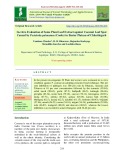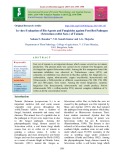
Poison food technique
-
In the present investigation 30 Plant leaf extract were evaluated in in vitro condition against P. palmarum adopting poisoned food technique. The per cent inhibition of pathogen was 100 per cent by Dhatura, Anjwain and Tobacco at 10 per cent concentration followed by the turmeric (95.84), safed musli (90.62), garlic (87.5), hathjodh (86.5), kalmegh (86.46), jetropha (83.34), neem bark (79.18), satavar (78.12), lemongrass (69.81), laung (67.71), ashoka (65.62), aadusa (63.68), karanj bark (63.06), bhringraj (62.5), karanj (62.5), dalchini (61.15), beshram (60.43), brijdanti (57.
 7p
7p  angicungduoc6
angicungduoc6
 22-07-2020
22-07-2020
 19
19
 1
1
 Download
Download
-
Foot rot of tomato is an important disease which causes severe loss in tomato production. The present study was carried out to evaluate five bioagents and six fungicides against Sclerotium rolfsii. Among the five antagonists tested the maximum inhibition was observed in Trichoderma virens (67%) and contrarily, no inhibition was observed in Bacillus subtilis. Six fungicides viz., carbendazim, captan, tebuconozole, copper oxychloride, hexaconozole and Tebuconazole +Trifloxytrobin at different concentrations (50, 100, 150, 200, 250 and 500 ppm), were tested.
 8p
8p  chauchaungayxua6
chauchaungayxua6
 26-06-2020
26-06-2020
 19
19
 4
4
 Download
Download
CHỦ ĐỀ BẠN MUỐN TÌM















